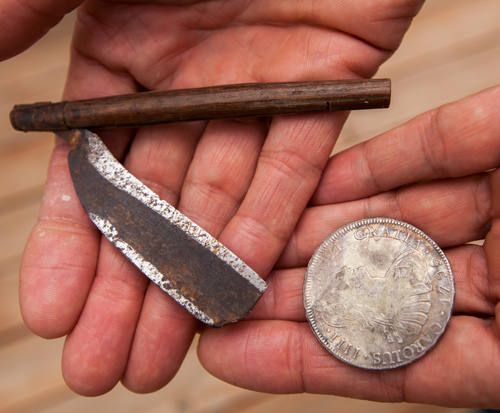Regulations
Razor and Spanish Mill Dollar
Historical interpretation by John W. Fisher. Photo © 2013 by Kristopher K. Townsend. Permission to use granted under the Creative Commons Attribution-Share Alike 4.0 International license.
The book of Regulations that Baron von Steuben prepared for the American army at the beginning of the War for Independence contained the direction that officers were to see that their men’s hands and faces were daily “washed clean” and their hair combed. It was an element of personal pride and self-respect: “field officers must pay attention to this object,” the baron continued, “taking proper notice of those companies where a visible neglect appears, and publickly applauding those who are remarkable for their good appearance.”[1]Friedrich Wilhelm von Steuben, Regulations for the Order and Discipline of the Troops of the United States (Boston: Thomas & Andrews, 1794), 49.
Soap
Soap was not mentioned in the baron’s directive, although it may have been implied by his “washed clean.” Nor were towels mentioned at any time in any context. Most of the enlisted men would have been familiar with that routine. The truth is that soap was relatively expensive for many people, and if individuals or families couldn’t manage to make their own with fat from their butchered animals and lye with the ashes from their stoves, they just went without. Moreover, the invention of the shower had to await the introduction of “running water” piped in from elevated tanks much later in the 19th century, and bathing one’s body in a tub was a luxury of the wealthiest urban homeowners. The last resort, at least for rural families, was to bathe in the nearest stream or river, when outdoor temperatures didn’t prevent it.
As we have pointed out elsewhere (see Outfitting the Expedition), the Corps of Discovery started out with a supply of presumably hard soap (bar soap); liquid soap would have been cheaper than bar soap, but harder to ration equitably, day after day, while on the road. But there is nary a clue as to precisely when or where they ran out of it. At Camp Dubois on 16 January 1804, Clerk “settled with the Contractor for what has been furnished to this day, and find him Due the Party 30 gills of whiskey which he payd,–and 750 rats. [rations] of Soap,” etc. We can suppose that those rations were in the form of “hard” or bar soap, but we don’t know the size or each bar, nor how much each weighed, so we have no bases for judging how long that quantity would have lasted. But if one bar would be sufficient for even one day’s use by 32 persons, it should have lasted at least through the Fort Clatsop residence, so they must have used it to wash their fabric clothing weekly until late 1804, at least. And on April 16, less than a month before their departure, Clark listed eleven items, with soap included cryptically in this context:
2 Boxes of candles
one part of Soap
44 Kegs of Pork packed w[t] 3115
Thus we are left wondering how much soap they had on hand when the expedition officially began.
Razors
As to other personal hygiene equipage, a few brief remarks will suffice to indicate that at the opening of the 21st century we are not very far beyond the state of domestic technology that was commonplace to Lewis and Clark and their men. To begin with, it appears that at least some of their straight razors had become useless well before they reached the Pacific, so not all the men could shave beards and mustaches, but only trim them with scissors, like head hair, when they grew long enough. (See the story of Frazer’s Razor, the worn-out razor he traded for two Spanish coins on the Snake River in May 1806.) But even for anyone with a still useable straight razor, shaving daily without soap would have been too painful to bear.
Bushing and Brushing
Toilet paper did not displace expensive rags or rag-based paper in high-class domestic “water closets,” or green leaves in rural outhouses, or on wilderness treks, until the mid 1850s, when wood pulp was introduced to produce affordable toilet paper. However, it was not free of occasional splinters until 1930. As to the now ubiquitous toothbrush, “twig brushes” or “chew sticks,” were in use worldwide for several millennia before the Christian era began, and for many generations thereafter, until mass production of nylon toothbrushes began in 1938. Systematic use of them didn’t begin until the soldiers returning from World War II brought with them the military routine of daily brushing. Up to that time, most anyone who felt a need for oral comfort used chew sticks, which were short tree twigs—the tastier the better, of course—with the bark peeled back and one end frayed or splintered sufficiently to produce a gentle abrasive effect. (Wikipedia articles and other websites and timelines will conveniently supply additional details about these amenities.
Notes
| ↑1 | Friedrich Wilhelm von Steuben, Regulations for the Order and Discipline of the Troops of the United States (Boston: Thomas & Andrews, 1794), 49. |
|---|
Experience the Lewis and Clark Trail
The Lewis and Clark Trail Experience—our sister site at lewisandclark.travel—connects the world to people and places on the Lewis and Clark Trail.
Discover More
- The Lewis and Clark Expedition: Day by Day by Gary E. Moulton (University of Nebraska Press, 2018). The story in prose, 14 May 1804–23 September 1806.
- The Lewis and Clark Journals: An American Epic of Discovery (abridged) by Gary E. Moulton (University of Nebraska Press, 2003). Selected journal excerpts, 14 May 1804–23 September 1806.
- The Lewis and Clark Journals. by Gary E. Moulton (University of Nebraska Press, 1983–2001). The complete story in 13 volumes.


